Simultaneous determination of borax and polyphosphates content in food by liquid chromatography inductively coupled plasma mass spectrometry (LC-ICP-MS)
A new method based on LC-ICP-MS technique has been developed and validated for
the simultaneous determination of borax and polyphosphates (phosphate, pyrophosphate,
tripolyphosphate) in foods. The analytes were extracted from the samples with 18 mM
sulfuric acid solution using ultrasonic vibration extraction technique before being filtered and
analyzed by LC-ICP-MS system. The method was validated with calibration curves that have
the coefficient of determination (R2) higher than 0.995. The method limits of detection (LOD)
of borax, phosphate, pyrophosphate (Pyro-P), and tripolyphosphate (Tripoly-P) were in the
range of 2.5 to 15.0 mg/kg. The recoveries were in the range of 86.0 to 107.0% and the relative
standard deviations were below 5.23%. A total of 83 samples of cereal, meat, and seafood-based
food were analyzed for research purposes. The results did not indicate a risk of using borax
and polyphosphates in most rice products. Meanwhile, meat products including pork paste and
roasted pork sold in traditional markets had a borax detection rate of over 60%. This study
showed that there was still a risk of using borax in food processing and the use of polyphosphates
in food products collected in some districts in Hanoi city.
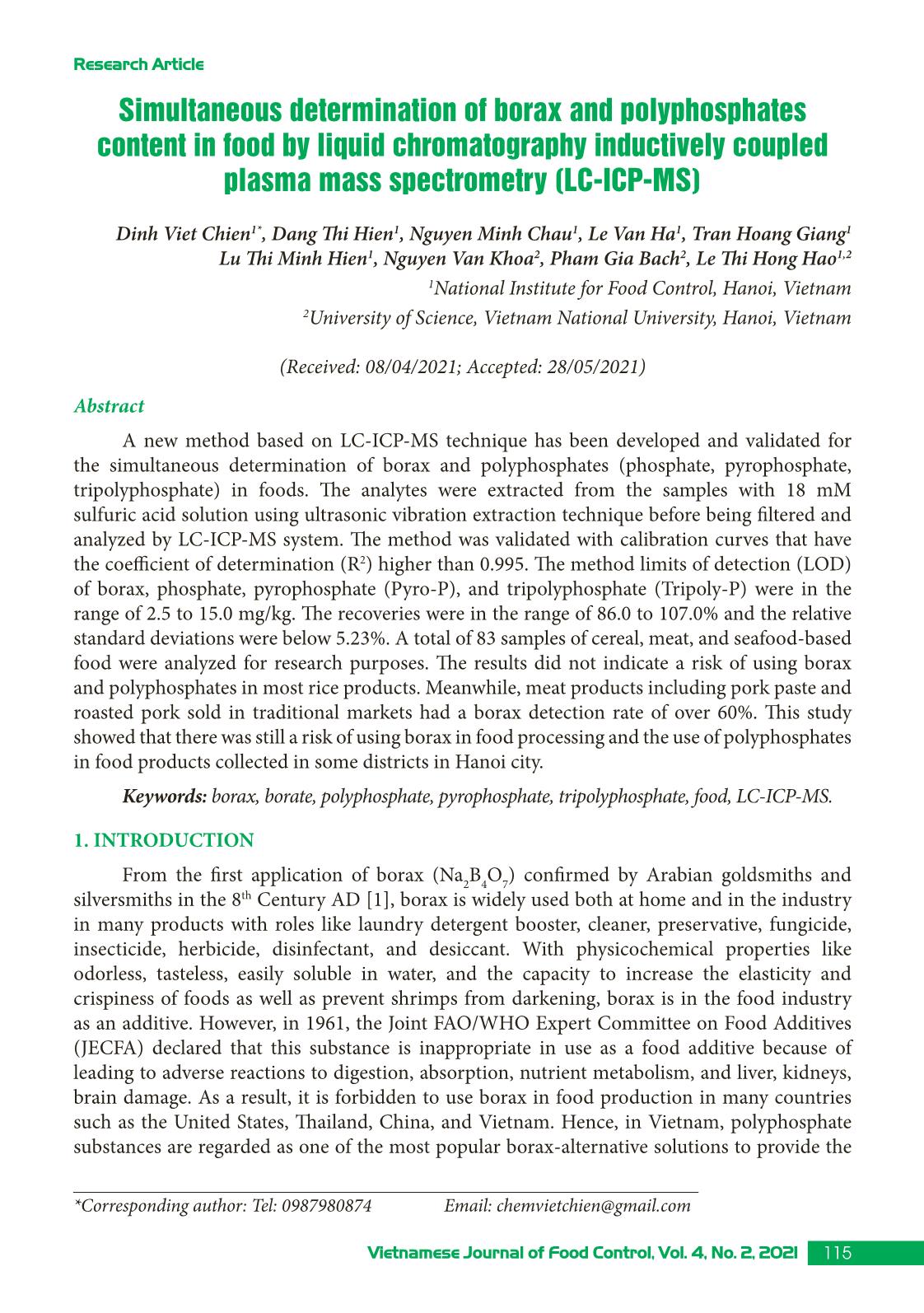
Trang 1
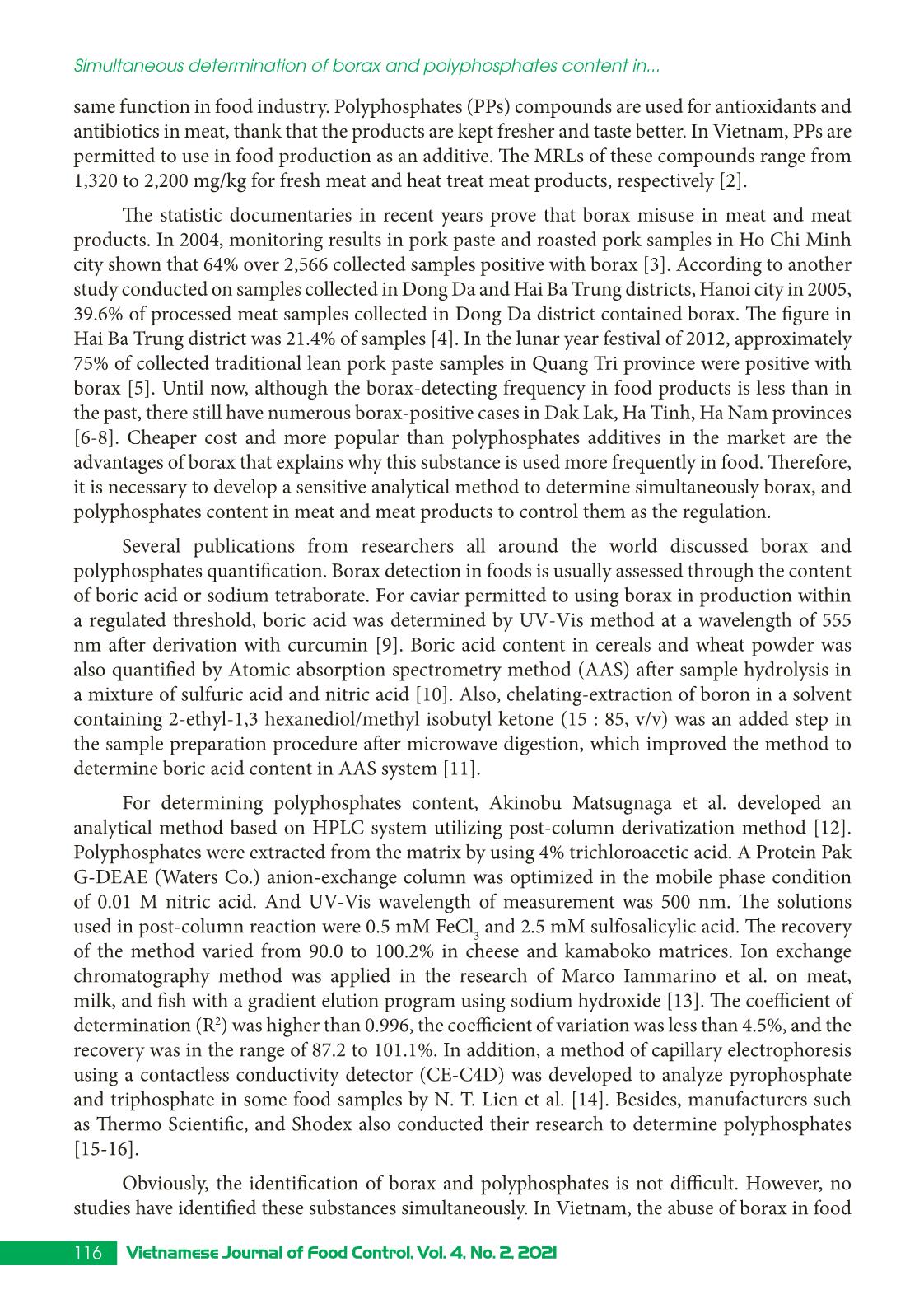
Trang 2
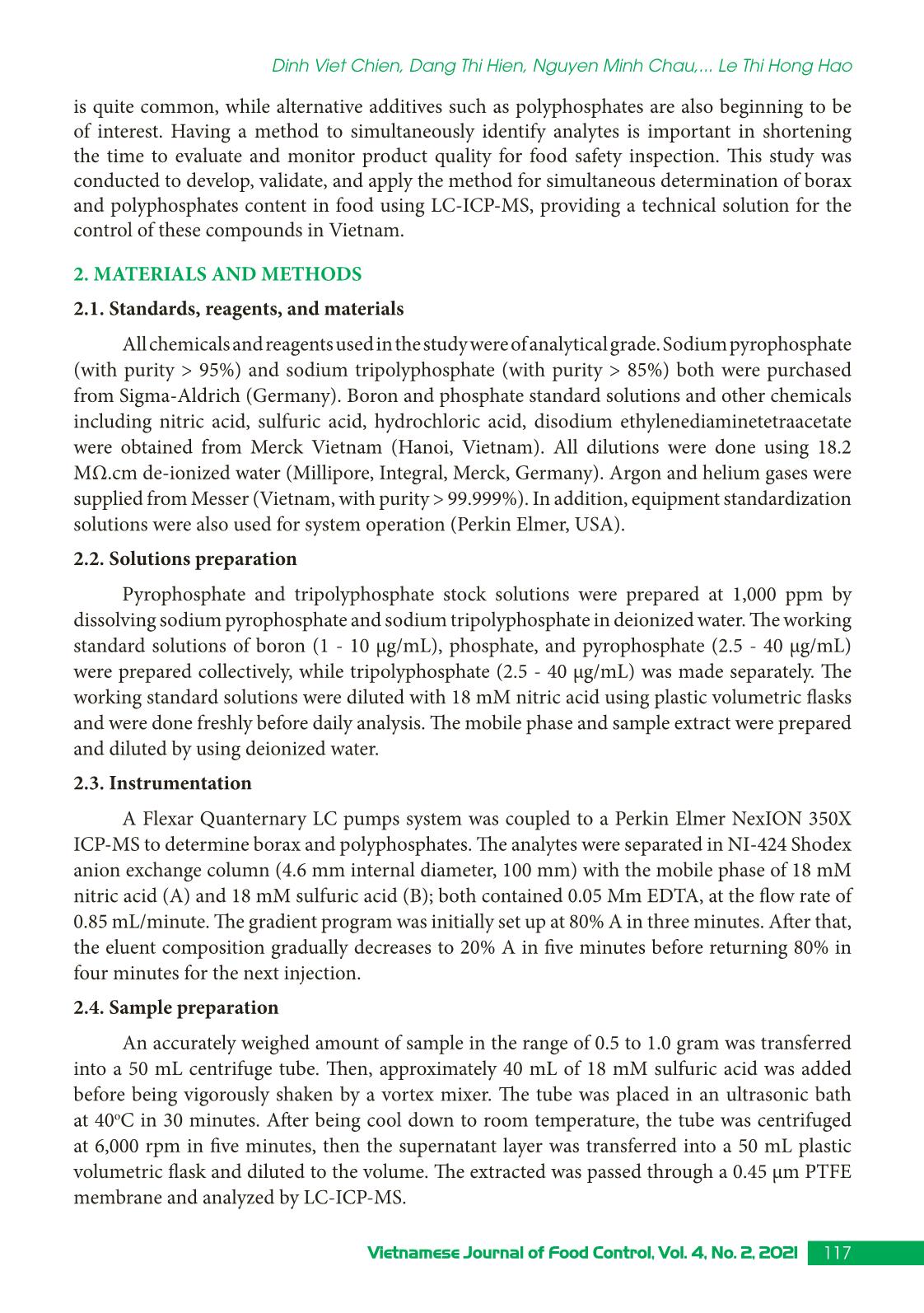
Trang 3
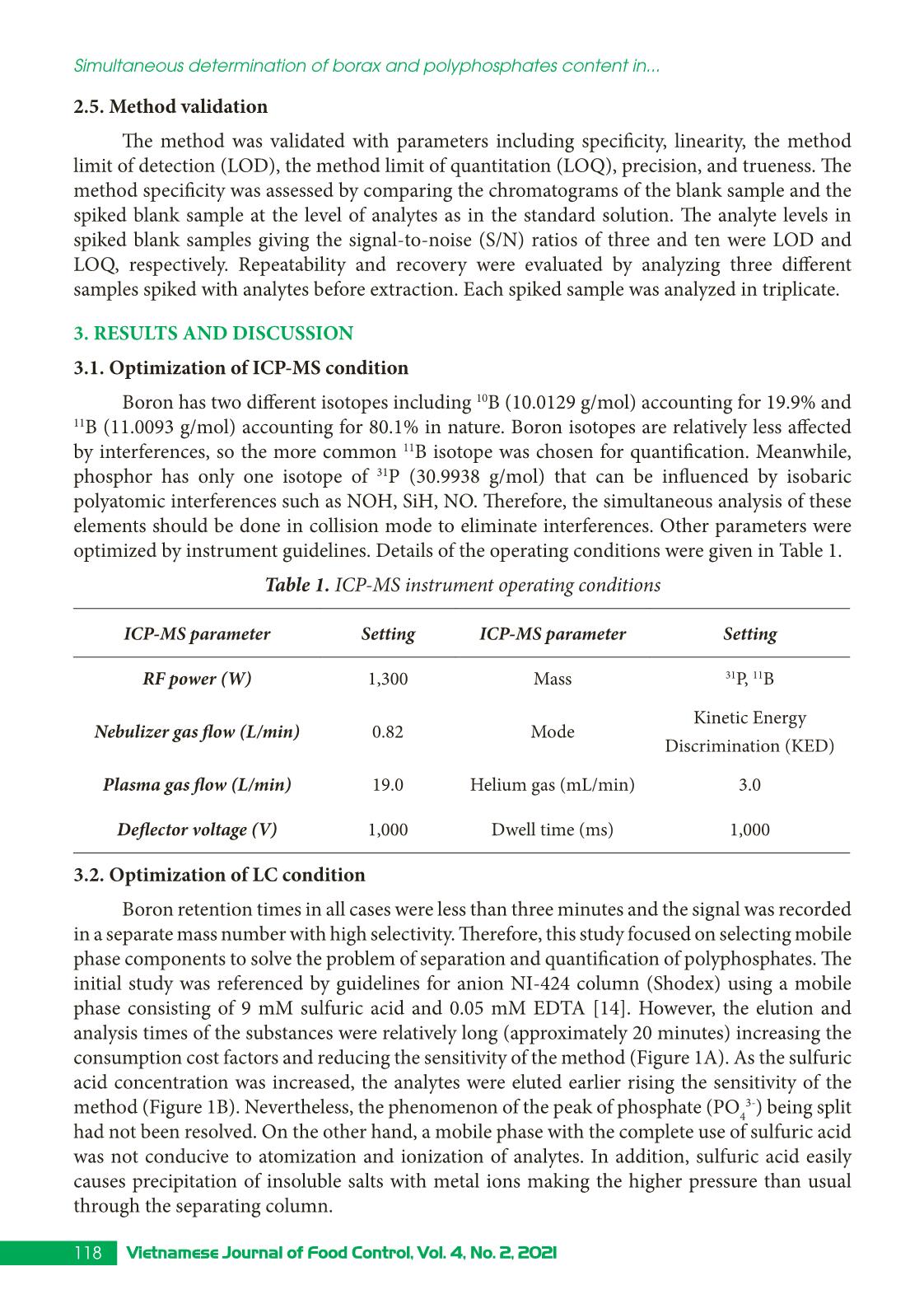
Trang 4
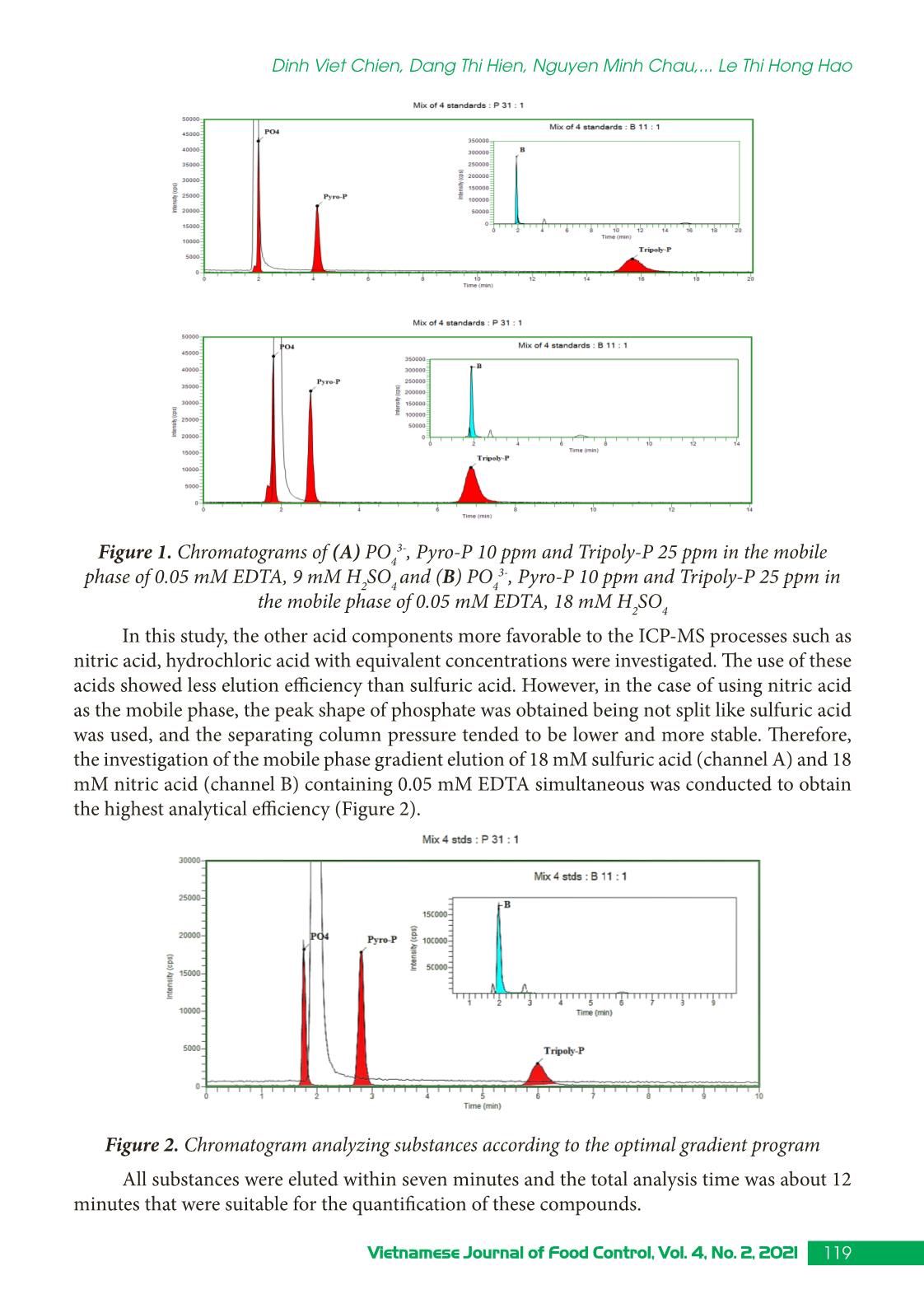
Trang 5

Trang 6
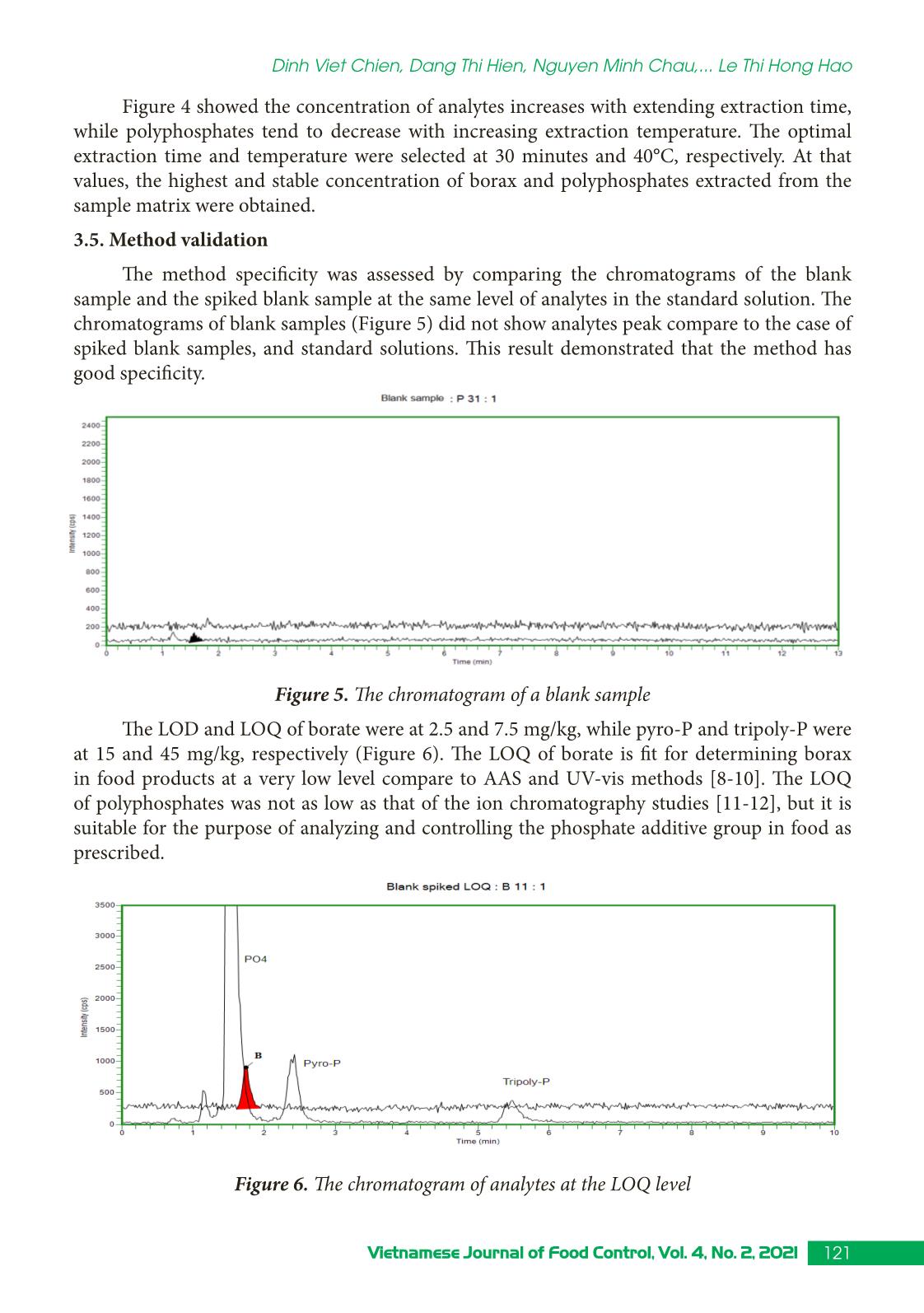
Trang 7
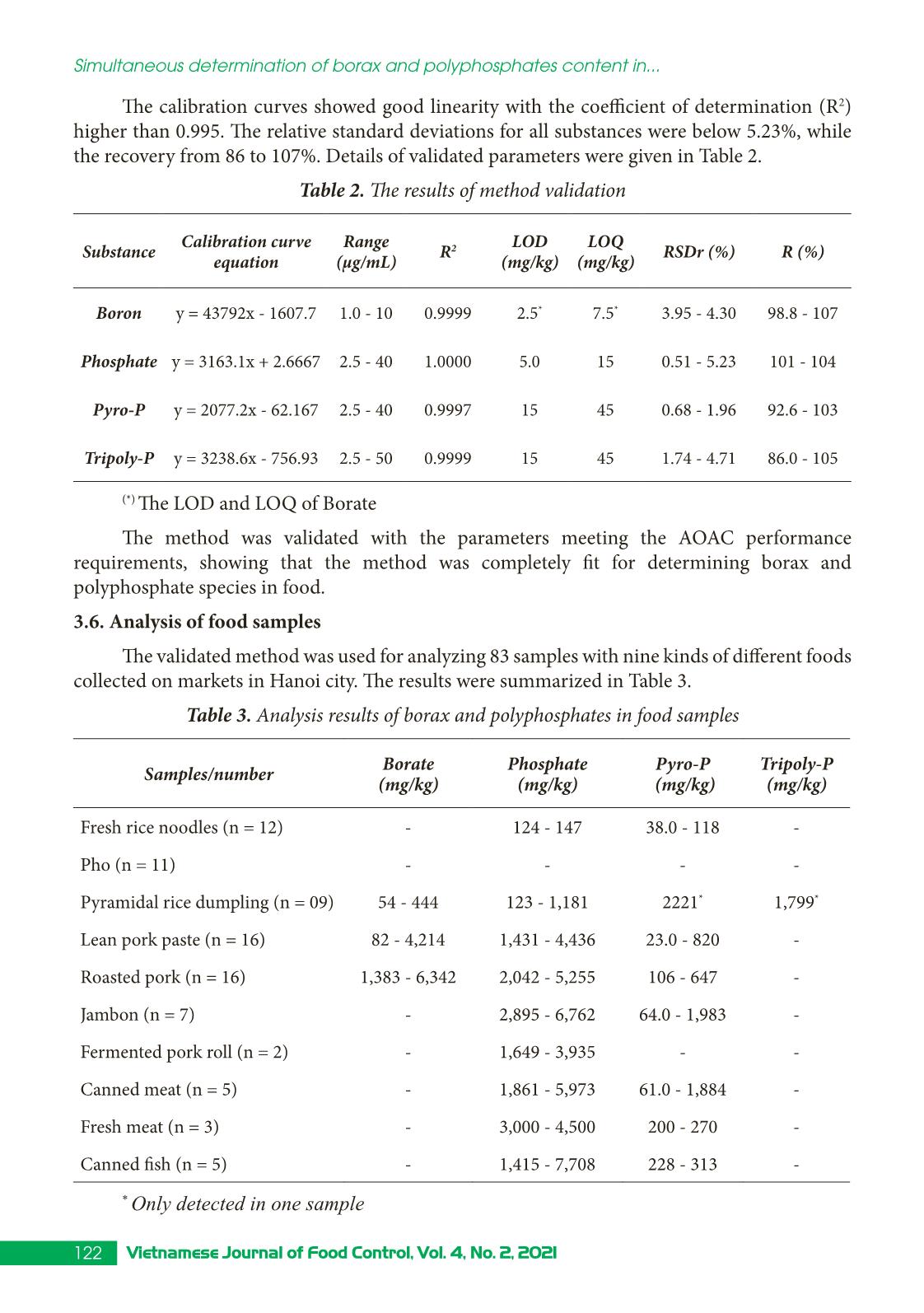
Trang 8
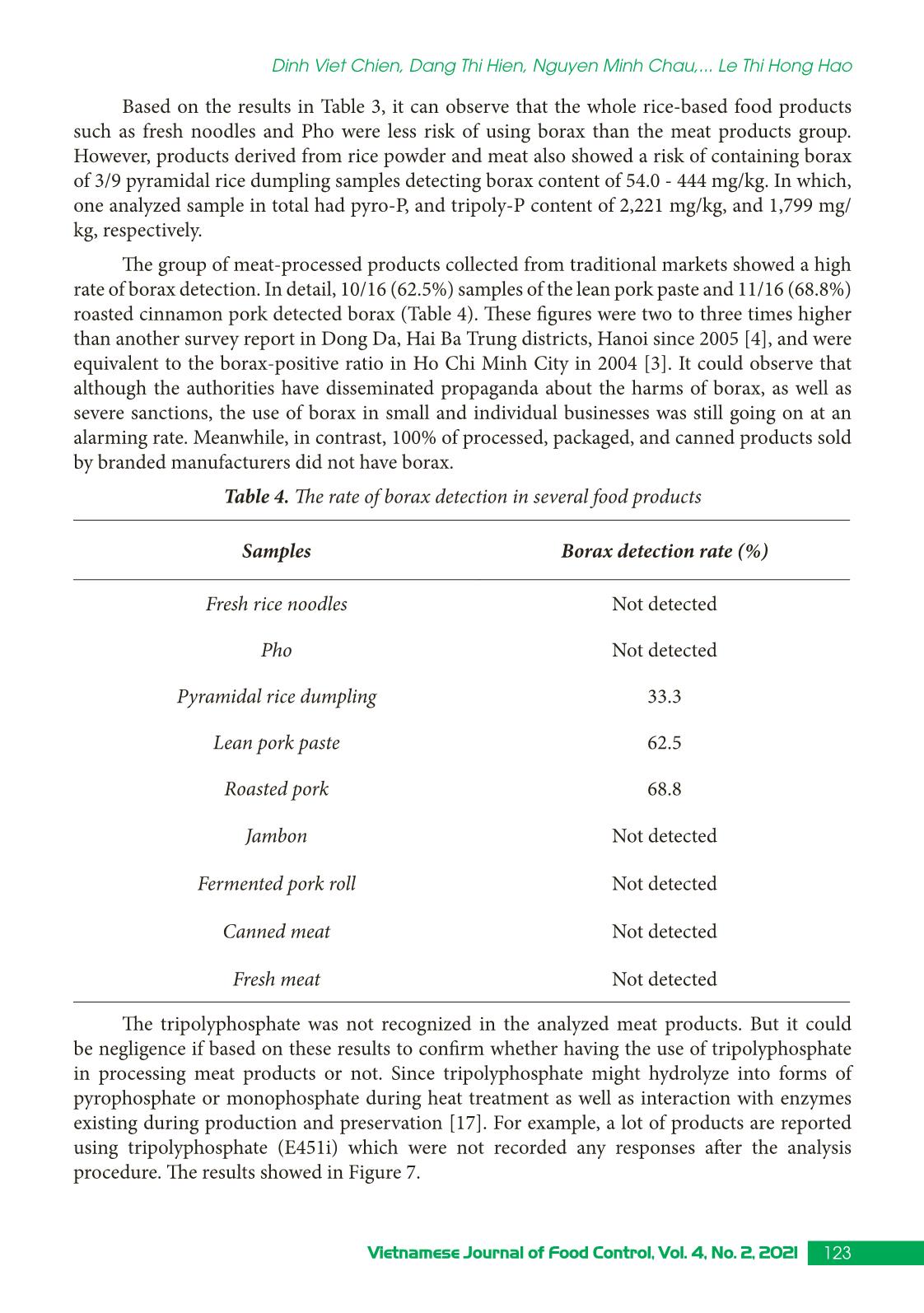
Trang 9
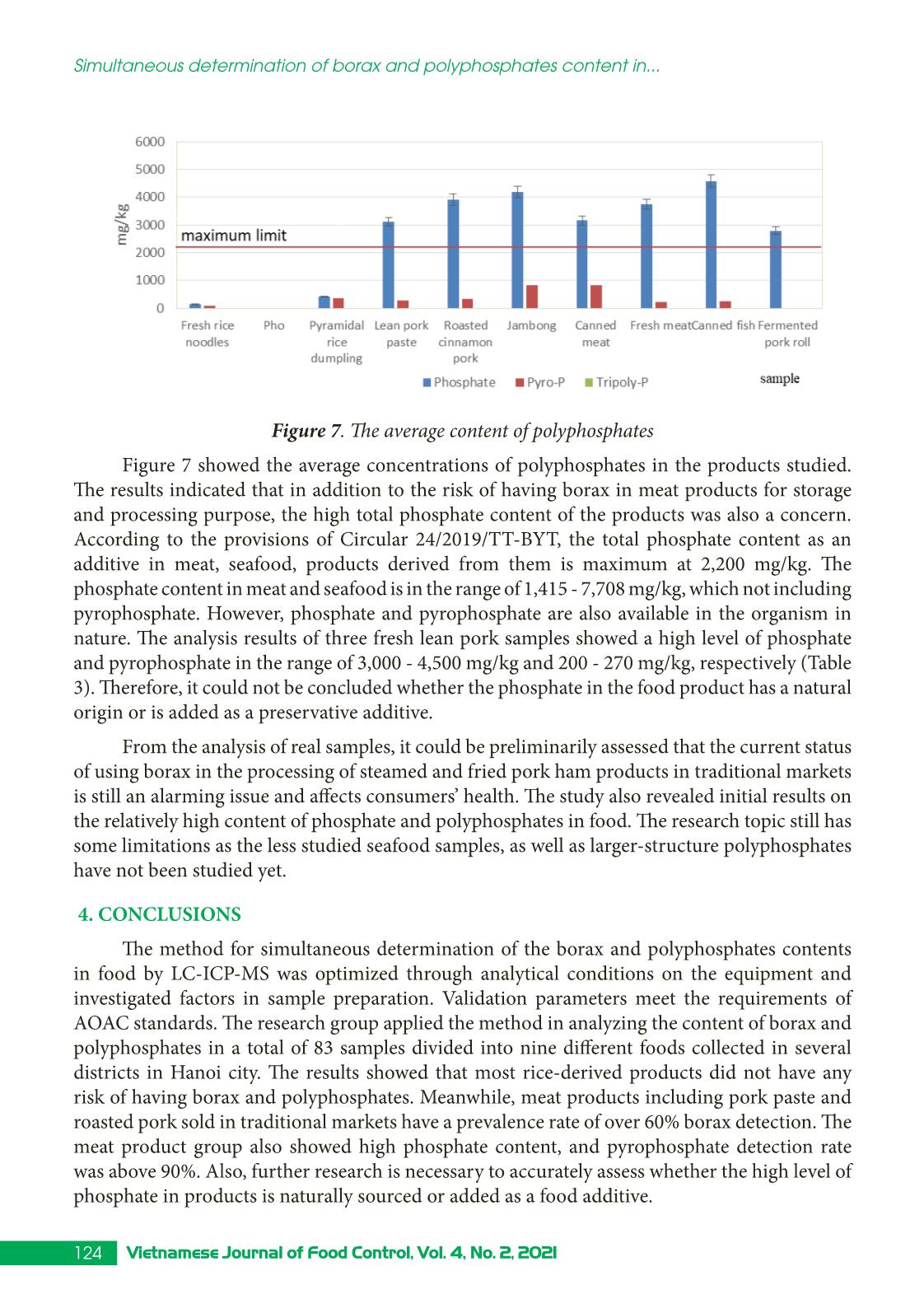
Trang 10
Tải về để xem bản đầy đủ
Tóm tắt nội dung tài liệu: Simultaneous determination of borax and polyphosphates content in food by liquid chromatography inductively coupled plasma mass spectrometry (LC-ICP-MS)
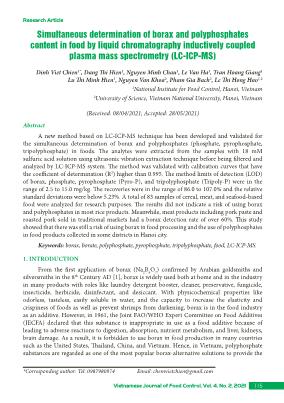
Research Article 115Vietnamese Journal of Food Control, Vol. 4, No. 2, 2021 Simultaneous determination of borax and polyphosphates content in food by liquid chromatography inductively coupled plasma mass spectrometry (LC-ICP-MS) Dinh Viet Chien1*, Dang Thi Hien1, Nguyen Minh Chau1, Le Van Ha1, Tran Hoang Giang1 Lu Thi Minh Hien1, Nguyen Van Khoa2, Pham Gia Bach2, Le Thi Hong Hao1,2 1National Institute for Food Control, Hanoi, Vietnam 2University of Science, Vietnam National University, Hanoi, Vietnam (Received: 08/04/2021; Accepted: 28/05/2021) Abstract A new method based on LC-ICP-MS technique has been developed and validated for the simultaneous determination of borax and polyphosphates (phosphate, pyrophosphate, tripolyphosphate) in foods. The analytes were extracted from the samples with 18 mM sulfuric acid solution using ultrasonic vibration extraction technique before being filtered and analyzed by LC-ICP-MS system. The method was validated with calibration curves that have the coefficient of determination (R2) higher than 0.995. The method limits of detection (LOD) of borax, phosphate, pyrophosphate (Pyro-P), and tripolyphosphate (Tripoly-P) were in the range of 2.5 to 15.0 mg/kg. The recoveries were in the range of 86.0 to 107.0% and the relative standard deviations were below 5.23%. A total of 83 samples of cereal, meat, and seafood-based food were analyzed for research purposes. The results did not indicate a risk of using borax and polyphosphates in most rice products. Meanwhile, meat products including pork paste and roasted pork sold in traditional markets had a borax detection rate of over 60%. This study showed that there was still a risk of using borax in food processing and the use of polyphosphates in food products collected in some districts in Hanoi city. Keywords: borax, borate, polyphosphate, pyrophosphate, tripolyphosphate, food, LC-ICP-MS. 1. INTRODUCTION From the first application of borax (Na2B4O7) confirmed by Arabian goldsmiths and silversmiths in the 8th Century AD [1], borax is widely used both at home and in the industry in many products with roles like laundry detergent booster, cleaner, preservative, fungicide, insecticide, herbicide, disinfectant, and desiccant. With physicochemical properties like odorless, tasteless, easily soluble in water, and the capacity to increase the elasticity and crispiness of foods as well as prevent shrimps from darkening, borax is in the food industry as an additive. However, in 1961, the Joint FAO/WHO Expert Committee on Food Additives (JECFA) declared that this substance is inappropriate in use as a food additive because of leading to adverse reactions to digestion, absorption, nutrient metabolism, and liver, kidneys, brain damage. As a result, it is forbidden to use borax in food production in many countries such as the United States, Thailand, China, and Vietnam. Hence, in Vietnam, polyphosphate substances are regarded as one of the most popular borax-alternative solutions to provide the *Corresponding author: Tel: 0987980874 Email: chemvietchien@gmail.com 116 Vietnamese Journal of Food Control, Vol. 4, No. 2, 2021 Simultaneous determination of borax and polyphosphates content in... same function in food industry. Polyphosphates (PPs) compounds are used for antioxidants and antibiotics in meat, thank that the products are kept fresher and taste better. In Vietnam, PPs are permitted to use in food production as an additive. The MRLs of these compounds range from 1,320 to 2,200 mg/kg for fresh meat and heat treat meat products, respectively [2]. The statistic documentaries in recent years prove that borax misuse in meat and meat products. In 2004, monitoring results in pork paste and roasted pork samples in Ho Chi Minh city shown that 64% over 2,566 collected samples positive with borax [3]. According to another study conducted on samples collected in Dong Da and Hai Ba Trung districts, Hanoi city in 2005, 39.6% of processed meat samples collected in Dong Da district contained borax. The figure in Hai Ba Trung district was 21.4% of samples [4]. In the lunar year festival of 2012, approximately 75% of collected traditional lean pork paste samples in Quang Tri province were positive with borax [5]. Until now, although the borax-detecting frequency in food products is less than in the past, there still have numerous borax-positive cases in Dak Lak, Ha Tinh, Ha Nam provinces [6-8]. Cheaper cost and more popular than polyphosphates additives in the market are the advantages of borax that explains why this substance is used more frequently in food. Therefore, it is necessary to develop a sensitive analytical method to determine simultaneously borax, and polyphosphates content in meat and meat products to control them as the regulation. Several publications from researchers all around the world discussed borax and polyphosphates quantification ... racted in deionized water or diluted acid solvents. Meanwhile, deionized water is normally used to be a solvent extracting phosphate and polyphosphate compounds. In this study, deionized water and acid components of the mobile phase including 18 mM nitric acid and 18 mM sulfuric acid were selected to investigate the effect of extraction solvent. The results were given in Figure 3. Figure 3. Investigation of the effect of extraction solvents on polyphosphates analysis The bar chart showed the different solvents giving extraction efficiency equivalent to Boron while using 18 mM sulfuric acid gave better extraction efficiency with phosphate and polyphosphate compounds. Thus, 18 mM sulfuric acid was chosen as the extraction solvent to carry out further investigations for sample treatment process. 3.4. Investigation of the effects of extraction time and temperature After selecting the extraction solvent, other conditions were also investigated to obtain the optimum parameters for the extraction process such as extraction time and temperature. The extraction time was studied in the range of 15 to 40 minutes with each step of five minutes and the extraction temperature in the range of 30 to 80oC with each transition being 10oC. The results were indicated in Figure 4. Figure 4. The effects of sample extraction time (A) and temperature (B) 121Vietnamese Journal of Food Control, Vol. 4, No. 2, 2021 Dinh Viet Chien, Dang Thi Hien, Nguyen Minh Chau,... Le Thi Hong Hao Figure 4 showed the concentration of analytes increases with extending extraction time, while polyphosphates tend to decrease with increasing extraction temperature. The optimal extraction time and temperature were selected at 30 minutes and 40°C, respectively. At that values, the highest and stable concentration of borax and polyphosphates extracted from the sample matrix were obtained. 3.5. Method validation The method specificity was assessed by comparing the chromatograms of the blank sample and the spiked blank sample at the same level of analytes in the standard solution. The chromatograms of blank samples (Figure 5) did not show analytes peak compare to the case of spiked blank samples, and standard solutions. This result demonstrated that the method has good specificity. Figure 5. The chromatogram of a blank sample The LOD and LOQ of borate were at 2.5 and 7.5 mg/kg, while pyro-P and tripoly-P were at 15 and 45 mg/kg, respectively (Figure 6). The LOQ of borate is fit for determining borax in food products at a very low level compare to AAS and UV-vis methods [8-10]. The LOQ of polyphosphates was not as low as that of the ion chromatography studies [11-12], but it is suitable for the purpose of analyzing and controlling the phosphate additive group in food as prescribed. Figure 6. The chromatogram of analytes at the LOQ level 122 Vietnamese Journal of Food Control, Vol. 4, No. 2, 2021 Simultaneous determination of borax and polyphosphates content in... The calibration curves showed good linearity with the coefficient of determination (R2) higher than 0.995. The relative standard deviations for all substances were below 5.23%, while the recovery from 86 to 107%. Details of validated parameters were given in Table 2. Table 2. The results of method validation Substance Calibration curve equation Range (µg/mL) R 2 LOD (mg/kg) LOQ (mg/kg) RSDr (%) R (%) Boron y = 43792x - 1607.7 1.0 - 10 0.9999 2.5* 7.5* 3.95 - 4.30 98.8 - 107 Phosphate y = 3163.1x + 2.6667 2.5 - 40 1.0000 5.0 15 0.51 - 5.23 101 - 104 Pyro-P y = 2077.2x - 62.167 2.5 - 40 0.9997 15 45 0.68 - 1.96 92.6 - 103 Tripoly-P y = 3238.6x - 756.93 2.5 - 50 0.9999 15 45 1.74 - 4.71 86.0 - 105 (*) The LOD and LOQ of Borate The method was validated with the parameters meeting the AOAC performance requirements, showing that the method was completely fit for determining borax and polyphosphate species in food. 3.6. Analysis of food samples The validated method was used for analyzing 83 samples with nine kinds of different foods collected on markets in Hanoi city. The results were summarized in Table 3. Table 3. Analysis results of borax and polyphosphates in food samples Samples/number Borate(mg/kg) Phosphate (mg/kg) Pyro-P (mg/kg) Tripoly-P (mg/kg) Fresh rice noodles (n = 12) - 124 - 147 38.0 - 118 - Pho (n = 11) - - - - Pyramidal rice dumpling (n = 09) 54 - 444 123 - 1,181 2221* 1,799* Lean pork paste (n = 16) 82 - 4,214 1,431 - 4,436 23.0 - 820 - Roasted pork (n = 16) 1,383 - 6,342 2,042 - 5,255 106 - 647 - Jambon (n = 7) - 2,895 - 6,762 64.0 - 1,983 - Fermented pork roll (n = 2) - 1,649 - 3,935 - - Canned meat (n = 5) - 1,861 - 5,973 61.0 - 1,884 - Fresh meat (n = 3) - 3,000 - 4,500 200 - 270 - Canned fish (n = 5) - 1,415 - 7,708 228 - 313 - * Only detected in one sample 123Vietnamese Journal of Food Control, Vol. 4, No. 2, 2021 Dinh Viet Chien, Dang Thi Hien, Nguyen Minh Chau,... Le Thi Hong Hao Based on the results in Table 3, it can observe that the whole rice-based food products such as fresh noodles and Pho were less risk of using borax than the meat products group. However, products derived from rice powder and meat also showed a risk of containing borax of 3/9 pyramidal rice dumpling samples detecting borax content of 54.0 - 444 mg/kg. In which, one analyzed sample in total had pyro-P, and tripoly-P content of 2,221 mg/kg, and 1,799 mg/ kg, respectively. The group of meat-processed products collected from traditional markets showed a high rate of borax detection. In detail, 10/16 (62.5%) samples of the lean pork paste and 11/16 (68.8%) roasted cinnamon pork detected borax (Table 4). These figures were two to three times higher than another survey report in Dong Da, Hai Ba Trung districts, Hanoi since 2005 [4], and were equivalent to the borax-positive ratio in Ho Chi Minh City in 2004 [3]. It could observe that although the authorities have disseminated propaganda about the harms of borax, as well as severe sanctions, the use of borax in small and individual businesses was still going on at an alarming rate. Meanwhile, in contrast, 100% of processed, packaged, and canned products sold by branded manufacturers did not have borax. Table 4. The rate of borax detection in several food products Samples Borax detection rate (%) Fresh rice noodles Not detected Pho Not detected Pyramidal rice dumpling 33.3 Lean pork paste 62.5 Roasted pork 68.8 Jambon Not detected Fermented pork roll Not detected Canned meat Not detected Fresh meat Not detected The tripolyphosphate was not recognized in the analyzed meat products. But it could be negligence if based on these results to confirm whether having the use of tripolyphosphate in processing meat products or not. Since tripolyphosphate might hydrolyze into forms of pyrophosphate or monophosphate during heat treatment as well as interaction with enzymes existing during production and preservation [17]. For example, a lot of products are reported using tripolyphosphate (E451i) which were not recorded any responses after the analysis procedure. The results showed in Figure 7. 124 Vietnamese Journal of Food Control, Vol. 4, No. 2, 2021 Simultaneous determination of borax and polyphosphates content in... Figure 7. The average content of polyphosphates Figure 7 showed the average concentrations of polyphosphates in the products studied. The results indicated that in addition to the risk of having borax in meat products for storage and processing purpose, the high total phosphate content of the products was also a concern. According to the provisions of Circular 24/2019/TT-BYT, the total phosphate content as an additive in meat, seafood, products derived from them is maximum at 2,200 mg/kg. The phosphate content in meat and seafood is in the range of 1,415 - 7,708 mg/kg, which not including pyrophosphate. However, phosphate and pyrophosphate are also available in the organism in nature. The analysis results of three fresh lean pork samples showed a high level of phosphate and pyrophosphate in the range of 3,000 - 4,500 mg/kg and 200 - 270 mg/kg, respectively (Table 3). Therefore, it could not be concluded whether the phosphate in the food product has a natural origin or is added as a preservative additive. From the analysis of real samples, it could be preliminarily assessed that the current status of using borax in the processing of steamed and fried pork ham products in traditional markets is still an alarming issue and affects consumers’ health. The study also revealed initial results on the relatively high content of phosphate and polyphosphates in food. The research topic still has some limitations as the less studied seafood samples, as well as larger-structure polyphosphates have not been studied yet. 4. CONCLUSIONS The method for simultaneous determination of the borax and polyphosphates contents in food by LC-ICP-MS was optimized through analytical conditions on the equipment and investigated factors in sample preparation. Validation parameters meet the requirements of AOAC standards. The research group applied the method in analyzing the content of borax and polyphosphates in a total of 83 samples divided into nine different foods collected in several districts in Hanoi city. The results showed that most rice-derived products did not have any risk of having borax and polyphosphates. Meanwhile, meat products including pork paste and roasted pork sold in traditional markets have a prevalence rate of over 60% borax detection. The meat product group also showed high phosphate content, and pyrophosphate detection rate was above 90%. Also, further research is necessary to accurately assess whether the high level of phosphate in products is naturally sourced or added as a food additive. 125Vietnamese Journal of Food Control, Vol. 4, No. 2, 2021 Dinh Viet Chien, Dang Thi Hien, Nguyen Minh Chau,... Le Thi Hong Hao ACKNOWLEDGEMENT We would like to thank the National Institute for Food Control for the funding of this study. REFERENCES [1]. “Borax (Na2B4O7.10H2O) - Sodium Borate - Occurrence, Discovery and Applications,” Amoz.com. August 16, 2004. [2]. The Circular 24/2019/TT-BYT, Regulations on management and use of food additives. [3]. Thanh Tung, Formol is still rampant in pho - Borax is still spreading in spring rolls, https:// thanhnien.vn/suc-khoe/formol-van-tran-lan-trong-pho-han-the-van-tran-lan-trong- gio-cha-325759.htmL, 2006. [4]. D. T. Hoa, N. T. K. Dung, and T. X. Bach, “The situation of using borax and illegal food coloring in some processed foods at some markets in Dong Da and Hai Ba Trung districts - Hanoi 2005,” Journal Practical Medicine, no. 10, 2007. [5]. Quang Tri Sub-Department of Food Safety and Hygiene, “The issue of using borax in food,” trong-thuc-pham-16.html, December 19, 2012. [6]. T. H. Hoai, “Evaluation of food contamination in Dak Lak province from 2014 - 2018,” Vietnamese Journal of Food Control. vol. 2, no. 3, pp. 44-50, 2019. [7]. N. Duong, Ha Nam, “Fined VND 40 million, temporarily suspending production facilities using solder,” dinh-chi-co-so-san-xuat-gio-su-dung-han-the-tintuc456124, January 4, 2020. [8]. B. Nhung, “Powerless to control welding used to process and preserve food, https://baohatinh. vn/y-te/bat-luc-trong-kiem-soat-han-the-dung-che-bien-bao-quan-thuc-pham/148008. htm, January 17, 2018. [9]. AOAC Official Method 969.26, Spectrophotometric Method - Boric Acid in Caviar. [10]. AOAC Official Method 972.19, Atomic Absorption Spectrophotometric Method - Boric Acid in Food. [11]. AOAC Official Method 975.26, Emission Spectroscopic Method - Boric Acid in Food. [12]. Akinobu Matsunaga, Atsushi Yamamoto, Eiichi Mizukami, and Tooru Ooizumi, “Determination of Polyphosphates in Foods by High Performance Liquid Chromatography,” Published by Japanese Society for Food Science and Technology, vol. 37, no. 1, pp. 20-25, 1990. [13]. Marco Iammarino, Aurelia Di Taranto, “Determination of polyphosphates in products of animal origin: application of a validated ion chromatography method for commercial samples analyses,” European Food Research and Technology, vol. 235, pp. 409-417, 2012. [14]. N. T. Lien, N. T. A. Huong, C. V. Hoang, P. Q. Trung, and L. T. H. Hao, “Study on the process of simultaneous analysis of pyrophosphate and triphosphate in some food samples by capillary electrophoresis using non-contact conductivity detector (CE-C4D),” Journal of Analytical Chemistry, Physics and Biology, vol. 23, no. 1, pp. 121-127, 2018. [15]. Thermo Scientific, Determination of polyphosphates using ion chromatography, Application update 172, 2016. [16]. Shodex, Application search, analysis of pyrophosphate and tripolyphosphate [online], https://www.shodex.com/en/dc/07/06/15.html [Accessed date: 15/12/2020]. [17]. ISO 5553:1980. Meat and meat products - Detection of polyphosphates 126 Vietnamese Journal of Food Control, Vol. 4, No. 2, 2021 Simultaneous determination of borax and polyphosphates content in... Xác định đồng thời hàm lượng hàn the và các polyphosphate trong thực phẩm bằng phương pháp sắc ký lỏng ghép nối khối phổ plasma cao tần cảm ứng (LC-ICP-MS) Đinh Viết Chiến1*, Đặng Thị Hiên1, Nguyễn Minh Châu1, Lê Văn Hà1, Trần Hoàng Giang1 Lữ Thị Minh Hiền1, Nguyễn Văn Khoa1, Phạm Gia Bách2, Lê Thị Hồng Hảo1,2 1Viện Kiểm nghiệm an toàn vệ sinh thực phẩm Quốc gia, Hà Nội, Việt Nam 2Trường Đại học khoa học Tự nhiên, Đại học Quốc gia Hà Nội, Việt Nam Tóm tắt Phương pháp LC-ICP-MS đã được phát triển và thẩm định nhằm xác định đồng thời hàn the và các dạng polyphosphate (phosphate, pyrophosphate, tripolyphosphate) trong thực phẩm. Các chất phân tích được chiết ra khỏi nền mẫu bằng dung dịch acid sulfuric 18 mM sử dụng kỹ thuật chiết siêu âm, trước khi được lọc và phân tích trên hệ thống LC-ICP-MS. Phương pháp đã được thẩm định với các đường chuẩn cho hệ số tương quan tuyến tính R2 > 0,995. Giới hạn phát hiện của phương pháp với hàn the, phosphate, pyrophosphate và tripolyphosphate trong khoảng 2,5 - 15,0 mg/kg. Hiệu suất thu hồi trong khoảng 86,0 - 107,0% và độ lệch chuẩn tương đối lặp lại nhỏ hơn 5,23% cho thấy phương pháp có độ đúng và độ chụm tốt. Phương pháp được áp dụng để phân tích đồng thời hàm lượng của hàn the và polyphosphate trong 83 mẫu thực phẩm các loại có nguồn gốc ngũ cốc, thịt và thủy sản. Kết quả cho thấy, không có nguy cơ sử dụng hàn the và polyphosphate trong hầu hết các sản phẩm chế biến từ ngũ cốc. Trong khi đó, các sản phẩm thịt như giò và chả quế bán ở các chợ truyền thống có tỉ lệ phát hiện hàn the trên 60%. Kết quả nghiên cứu này cho thấy vẫn còn nguy cơ sử dụng hàn the trong chế biến thực phẩm. Từ khóa: hàn the, polyphosphate, pyrophosphate, tripolyphosphate, thực phẩm, LC-ICP-MS.
File đính kèm:
 simultaneous_determination_of_borax_and_polyphosphates_conte.pdf
simultaneous_determination_of_borax_and_polyphosphates_conte.pdf

